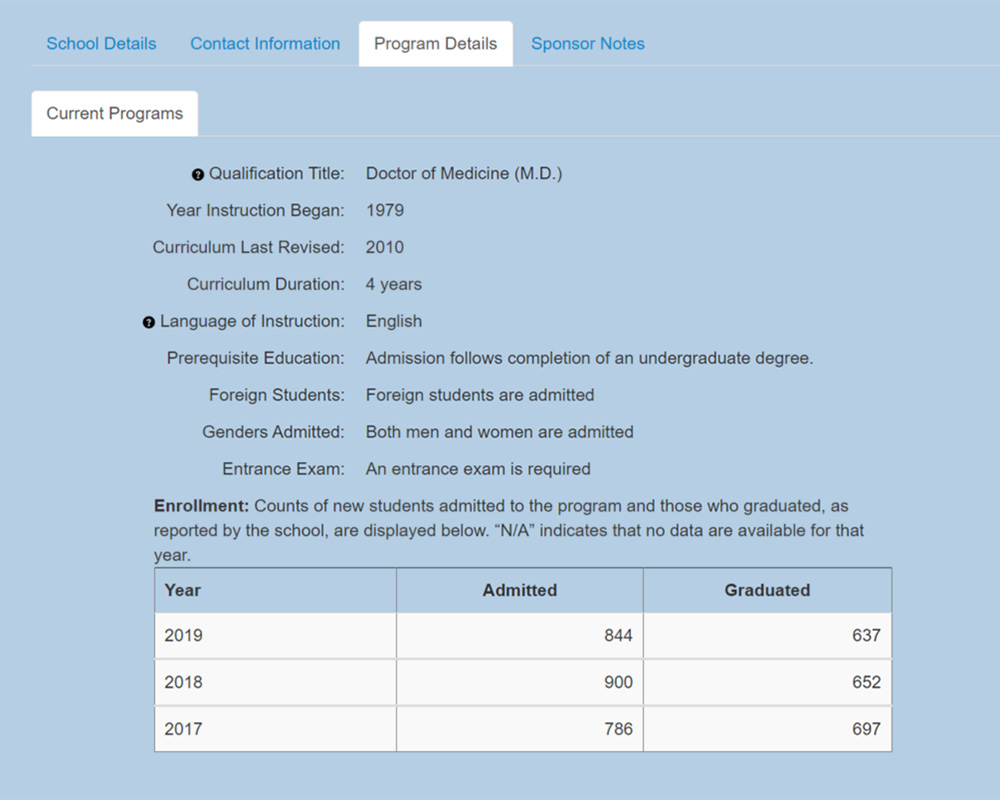Importance of Understading Data and Statistics
Pass and Success Rates
Understanding and obtaining pass and success rates from the school you are considering will give you many answers about the school. Schools in the Caribbean are very hesitant to share their real data and the actual statistics on student performance.
Definitions by the US Department of Education and NCFMEA
- First Time Pass Rate:
Similar to above but only taking into consideration students who are taking the USMLE exam for the first time (each Step).
- Graduation Rate:
The percentage of entering students who complete and graduate from the programs of study leading to an M.D. or its equivalent.
- Pass Rate:
The school's annual pass rate for each step will be determined by totaling the students and graduates in the denominator of each step, totaling the students and graduates successfully passing in the numerator, and dividing the numerator by the denominator for each calendar year.
- Retention Rate
The percentage of students who are enrolled in programs leading to the M.D, or its equivalent, at a foreign medical school, who continue their studies the following year.
IMG Performance
Educational Commission for Foreign Medical Graduates (ECFMG) is responsible for verifying foreign students’ credentials before allowing them to take the USMLE and apply for residency. Part of that process is to keep track of the overall performance of the IMGs on the standardized examinations. ECFMG publishes an annual report card and a detailed annual report showing the overall IMG performance in the standardized examinations and the Residency Matching Process. Additional detail regarding the Residency Match is also through the National Resident Matching Program. In summary, the IMG’s First Time USMLE Step 1 pass rate is 78% in 2021. The average Residency Match rate for the IMGs in 2021 is 51%. In comparison to this, the graduates of US medical schools, the first-time pass rate is 93%, while the residency match rate in 2021 was 93.8% (pg. 1 of the Annual MATCH report). For additional details on residency, please visit our Residency page.
| 2021 | US Allopathic Graduate | IMG |
|---|---|---|
| USMLE Step 1 First Time Pass Rate | 93% | 78% |
| Residency Match Rate | 93.8% | 51% |
Performance of the school
The ultimate goal of your efforts in obtaining a medical degree is to match for residency and become a licensed physician in your field of interest. Understanding how the students of the school you are considering are performing on the standardized examinations will give you an understanding of your chances for success.
Many schools in the Caribbean are advertising a 90%+ First Time Pass Rate on the USMLE Step 1. Some go as far as stating a 100% pass rate. This would mean that every student tested from that school passed the USMLE Step 1 examination on their first attempt. Is this possible? The answer is in detail...
In recent years some schools have instituted a pre-qualifying examination (usually NBME Basic Science Comprehensive Exam) to the USMLE Step 1 and Step 2. The others use the NBME Basic Science Comprehensive Exam as a final exam in one of the courses in their final semester of Basic Sciences. In either scenario, if you do not successfully pass the NBME Basic Science Comprehensive Examination you are not allowed to take the USMLE Step 1. Because there is an extremely high correlation between the NBME Basic Science Comprehensive Examination and the USMLE Step 1 (in our experience, the NBME exam is sometimes even more difficult than the USMLE Step 1), the schools would see very high pass rates (90%+). However, what that fails to tell you is that there are a potentially large number of students who are unable to complete the NBME Basic Science Comprehensive Examination. These students are usually given a period of time (6-12 months) following the completion of Basic Sciences to obtain the necessary knowledge on their own to pass the NBME Basic Science Comprehensive Exam. Aside from the fact that this will likely cost the student additional funds for signing up for a separate review program, your school will likely be of little to no help during this time. If you are unable to clear this exam within the timeframe given you will likely be dismissed from their program. This will almost ruin your chances of becoming a medical doctor. Even if you are lucky enough to transfer to another school and you ultimately pass the USMLE Step 1 Exam and complete the program, the Residency Program Directors will have a hard time overcoming the fact that you switched schools, were dismissed, and took a long time to pass the USMLE Step 1. One positive is that you have passed the USMLE Step 1 on the first attempt. To make up for the aforementioned drawbacks, it will be crucial to ensure that you do very well on the USMLE Step 2CK. With the Step 1 only offering a PASS/FAIL result, the Residency Program Directors are giving more weight to the USMLE Step 2CK score when ranking the residency applicants for their programs.

Tip #21: School showing/advertising high passing score on the USMLE Step 1 is great, but does not tell the whole story. Ask the school to tell you how many students enrolled into the program last year and how many students cleared the Step 1 this year.
You may find that the school enrolls 300 students annually, but only 100 students pass the USMLE Step 1 each year. If this is the case, the drop off rate (attrition) is very high (66%). The 200 students that have not passed the exam are likely no longer in school and no longer pursuing medicine.

Tip #22: There is no official method of verifying the attrition rate of the school. However, the enrollment and graduation data is shared with the accrediting bodies and, for accredited schools, some related information can be found on WDOMS, under the program details of each school.
See the screenshot on the right. This school has reported enrollment data and graduation data. Although there is a delay of 4-5 years between enrollment and graduation, the chances are that the data presented is still relevant as long as the school continues to enroll a similar number of students in the past. In the screenshot below, you will notice that the average graduation rate of this school is 63% (the assumption is that similar enrollment numbers took place in earlier years). When selecting your school, does a 63% success rate sound good? Maybe. Based on our experience in the Caribbean, this is pretty good. The school in the screenshot is highly accredited and has been in the market for a long time. Other non-accredited schools, which do not report this data, tend to have even lower graduation rates. Our experience shows that most of them have a graduation rate of 20-40%.
Also, please remember that graduating does not equal being a Resident! Please remember that the graduates of the International Medical Schools, as per ECFMG/NRPM, on average, match 51% of the time. That may be higher for this school, but we have no data to support that at this moment.


Tip #23: Passion beats any statistic.
While the statistics can offer a lot of insights into the performance of the schools vs. the peers, your success or failure will depend on only one thing- YOU. With over 15 years of experience working with Caribbean medical students, we have observed that success does not depend on IQ, prior experiences or even money... Success is most often tied to motivation and PASSION. Students who come to the Caribbean to study medicine, and came out of the program successfully, have dedicated themselves 100% to this cause. Their focus is entirely on accomplishing one goal- dedicating their entire time to studies so they can do well on the test and complete the program.
Latest blogs
We are pesenting you some of the question to ask the advisor
See the Questions

